#Brian Murray Pencils
Explore tagged Tumblr posts
Text
Supreme #3 (1993) Rob Liefeld Cover, Brian Murray Pencils, Brian Murray & Rob Liefeld Story
#Supreme #3 (1993) #RobLiefeld Cover, #BrianMurray Pencils, Brian Murray & Rob Liefeld Story "No Mercy" When an army of terrorists takes over 75 global delegates as hostages at Washington, D.C.'s Dulles Airport, Supreme arrives to handle the situation in a swift, brutal, and merciless fashion. https://www.rarecomicbooks.fashionablewebs.com/Image%202.html#3 @rarecomicbooks Website Link In Bio Page If Applicable. SAVE ON SHIPPING COST - NOW AVAILABLE FOR LOCAL PICK UP IN DELTONA, FLORIDA #KeyComicBooks #ImageComics #ImageUniverse

#Supreme#3 (1993) Rob Liefeld Cover#Brian Murray Pencils#Brian Murray & Rob Liefeld Story#Rare Comic Books#Key Comic Books#DC Comics#DCU#DC#Marvel Comics#MCU#Marvel#Marvel Universe#DC Universe#Dynamite Entertainment#Dark Horse Comic Books#Boom#IDW Publishing#Image Comics#Now Comics
0 notes
Text
The Folio Society to Publish "DC: Batman" Celebrating Batman's 85th Anniversary

The Folio Society and DC Comics are partnering on DC: Batman, a hardback book celebrating the Dark Knight's 85th anniversary. The 320-page deluxe compilation will include 12 seminal comics all selected and introduced by DC President, Publisher, and Editor-in-Chief Jennette Kahn. DC: Batman will also come with stand-alone replica copy of Batman #1, "scanned in its entirety from an original 1940 copy...which includes the original back-up strips and vintage ads and introduces DC’s Clown Prince of Crime, aka The Joker, and The Cat, who would come to be known as Catwoman." (DC Comics)
Per DC Comics, DC: Batman includes:
"Facsimile: Batman #1 (Spring 1940) Writer: Bill Finger Cover artists: Bob Kane, Jerry Robinson Artists: Bob Kane, Sheldon Moldoff Editor: Whitney Ellsworth
The Bat-Man Detective Comics #27 (May 1939) Writer: Bill Finger Artist: Bob Kane Editor: Vincent Sullivan
Robin—the Boy Wonder Detective Comics #38 (April 1940) Writer: Bill Finger Artists: Bob Kane, Jerry Robinson Editor: Whitney Ellsworth
The Crimes of Two-Face! Detective Comics #66 (August 1942) Writer: Bill Finger Artists: Jerry Robinson, George Roussos Letterers: Ira Schnapp Editor: Whitney Ellsworth
Batman and Green Arrow: The Senator’s Been Shot! The Brave and the Bold #85 (September 1969) Writer: Bob Haney Cover artist: Neal Adams Penciler: Neal Adams Inker: Dick Giordano Letterer: Ben Oda Editor: Murray Boltinoff
Daughter of the Demon Batman #232 (June 1971) Writer: Dennis O'Neil Cover artist: Neal Adams Penciler: Neal Adams Inker: Dick Giordano Letterer: John Costanza Editor: Julius Schwartz
The Dead Yet Live Detective Comics #471 (August 1977) Writer: Steve Englehart Cover artists: Marshall Rogers, Terry Austin, Tatjana Wood, Gaspar Saladino Penciler: Marshall Rogers Inker: Terry Austin Colorists: Marshall Rogers Letterer: John Workman Editors: Julius Schwartz, E. Nelson Bridwell
The Dark Knight Returns Batman: The Dark Knight Returns #1 (June 1986) Writer: Frank Miller Cover artists: Frank Miller, Lynn Varley Penciler: Frank Miller Inker: Klaus Janson Colorist: Lynn Varley Letterer: John Costanza Editors: Dick Giordano, Dennis O'Neil
Batman: Year One—Chapter One: Who I Am—How I Come to Be Batman #404 (February 1987) Writer: Frank Miller Artist: Dave Mazzucchelli Colorist: Richmond Lewis Letterer: Todd Klein Editor: Dennis O'Neil
Batman: The Killing Joke (July 1988) Writer: Alan Moore Cover artists: Brian Bolland, Richard Bruning Artist: Brian Bolland Colorist: John Higgins Letterer: Richard Starkings Editors: Dennis O'Neil, Dan Raspler
The Last Arkham (Part One) Batman: Shadow of the Bat #1 (June 1992) Writer: Alan Grant Cover artist: Brian Stelfreeze Penciler: Norm Breyfogle Inker: Norm Breyfogle Colorist: Adrienne Roy Letterer: Todd Klein Editors: Scott Peterson, Dennis O'Neil
Knightfall Part 1: Crossed Eyes and Dotty Teas Batman #492 (May 1993) Writer: Doug Moench Cover artists: Kelley Jones, Bob LeRose Penciler: Norm Breyfogle Inker: Norm Breyfogle Colorist Adrienne Roy Letterer: Richard Starkings Editors: Scott Peterson, Jordan B. Gorfinkel, Dennis O'Neil"
DC: Batman is available at The Folio Society.
(Image via DC Comics)
3 notes
·
View notes
Text
Folio Society Presents Batman!
(February 19, 2024) The Folio Society, independent publisher of beautifully illustrated hardback books, in collaboration with DC, will celebrate the 85th anniversary of the first comic book appearance of DC’s Dark Knight Detective with the release of DC: Batman. Created by Bob Kane with Bill Finger, Batman first appeared in 1939’s Detective Comics #27 and since then the Dark Knight has stood as a symbol of determination, courage and justice to generations of fans for over 80 years. Batman is one of the most iconic fictional characters in the world, and is a self-made Super Hero, notable not for his super powers, but for his intelligence, determination, and tech savvy.
This collectible compilation includes twelve seminal comics, by a host of iconic writers and artists— including Bill Finger, Bob Kane, Jerry Robinson, Denny O'Neil, Neal Adams, Marshall Rogers, Frank Miller, Dave Mazzucchelli, Alan Moore, Brian Bolland and Kelley Jones—all selected and introduced by former DC President, Publisher and Editor-in-Chief of DC, Jennette Kahn. Along with the 320-page one-of-a-kind deluxe book, DC: Batman also comes with a stand-alone replica copy of Batman #1. Scanned in its entirety from an original 1940 copy, the replica copy of the Batman #1 comic book, which includes the original back-up strips and vintage ads and introduces DC’s Clown Prince of Crime, aka The Joker, and The Cat, who would come to be known as Catwoman.
“Created towards the end of the Great Depression by artist Bob Kane with writer Bill Finger, Batman is an icon as familiar as James Bond or Tarzan, one who has evolved to reflect the changing attitudes of the twentieth century,” said Folio Society Head of Editorial, James Rose. “The stories selected for DC: Batman reveal how the character and his billionaire alter-ego Bruce Wayne gradually evolved from the dutiful crimefighter of the 1940s to a man possessed, as crazy as the criminals he puts away. The Caped Crusader faces a rogue’s gallery steeped in gothic horror, from the Weimar cinema-inspired The Joker to the Jekyll/Hyde figure of Two-Face and the Moriarty-like Ra's al Ghul.”
“Trauma is a through-line in the Batman mythology,” writes Jenette Kahn in her introduction. “It has made psychopaths of Batman’s foes and brought him to the edge of madness himself. Batman’s battle is not just against criminals and crime. He fears the day he’ll look into a mirror and see, not Bruce Wayne’s
face, but The Joker’s.” The first woman at the helm of the legendary comic book publisher, Jenette Kahn helped transform comics into a sophisticated art form during her 27-year tenure from 1976 to 2002.
“The Dark Knight Returns by Frank Miller and Batman: Year One, by Miller and Dave Mazzucchelli, and the terrifying classic The Killing Joke by Alan Moore and Brian Bolland are widely regarded as among the greatest comic books ever created,” said Folio Society Publishing Director, Tom Walker. “These stories changed the graphic medium forever with their combination of cinematic storytelling, shocking violence and literary depth and serve as centerpiece texts for DC: Batman.”
DC: Batman includes:
Facsimile: Batman #1 (Spring 1940)
Writer: Bill Finger
Cover artists: Bob Kane, Jerry Robinson
Artists: Bob Kane, Sheldon Moldoff
Editor: Whitney Ellsworth
The Bat-Man
Detective Comics #27 (May 1939)
Writer: Bill Finger
Artist: Bob Kane Editor: Vincent Sullivan
Robin—the Boy Wonder
Detective Comics #38 (April 1940)
Writer: Bill Finger
Artists: Bob Kane, Jerry Robinson Editor: Whitney Ellsworth
The Crimes of Two-Face!
Detective Comics #66 (August 1942)
Writer: Bill Finger
Artists: Jerry Robinson, George Roussos
Letterers: Ira Schnapp Editor: Whitney Ellsworth
Batman and Green Arrow: The Senator’s Been Shot!
The Brave and the Bold #85 (September 1969)
Writer: Bob Haney Cover artist: Neal Adams
Penciler: Neal Adams
Inker: Dick Giordano
Letterer: Ben Oda
Editor: Murray Boltinoff
Daughter of the Demon
Batman #232 (June 1971)
Writer: Dennis O'Neil
Cover artist: Neal Adams
Penciler: Neal Adams
Inker: Dick Giordano
Letterer: John Costanza
Editor: Julius Schwartz
The Dead Yet Live
Detective Comics #471 (August 1977)
Writer: Steve Englehart
Cover artists: Marshall Rogers, Terry Austin, Tatjana Wood, Gaspar Saladino
Penciler: Marshall Rogers
Inker: Terry Austin
Colorists: Marshall Rogers
Letterer: John Workman
Editors: Julius Schwartz, E. Nelson Bridwell
The Dark Knight Returns
Batman: The Dark Knight Returns #1 (June 1986)
Writer: Frank Miller
Cover artists: Frank Miller, Lynn Varley
Penciler: Frank Miller
Inker: Klaus Janson
Colorist: Lynn Varley
Letterer: John Costanza
Editors: Dick Giordano, Dennis O'Neil
Batman: Year One—Chapter One: Who I Am—How I Come to Be
Batman #404 (February 1987)
Writer: Frank Miller
Artist: Dave Mazzucchelli
Colorist: Richmond Lewis
Letterer: Todd Klein
Editor: Dennis O'Neil
Batman: The Killing Joke (July 1988)
Writer: Alan Moore
Cover artists: Brian Bolland, Richard Bruning
Artist: Brian Bolland
Colorist: John Higgins
Letterer: Richard Starkings
Editors: Dennis O'Neil, Dan Raspler
The Last Arkham (Part One)
Batman: Shadow of the Bat #1 (June 1992)
Writer: Alan Grant
Cover artist: Brian Stelfreeze
Penciler: Norm Breyfogle
Inker: Norm Breyfogle
Colorist: Adrienne Roy
Letterer: Todd Klein
Editors: Scott Peterson, Dennis O'Neil
Knightfall Part 1: Crossed Eyes and Dotty Teas
Batman #492 (May 1993)
Writer: Doug Moench
Cover artists: Kelley Jones, Bob LeRose
Penciler: Norm Breyfogle
Inker: Norm Breyfogle
Colorist Adrienne Roy
Letterer: Richard Starkings
Editors: Scott Peterson, Jordan B. Gorfinkel, Dennis O'Neil
The release of DC: Batman is the second release in the Folio Society publishing program with DC, following the release of the acclaimed DC: The Golden Age. DC: Batman has been made according to The Folio Society’s exceptional production standards. Scanned from original copies held in the DC archives, the comics have been reproduced in 10” x 7” treasury format. An anti-scratch laminated hardcover features Batman’s signature silhouette, with titles foil-embossed in yellow and midnight blue, the book itself cowled in a pitch-black slipcase bearing the famous Bat-Signal. A compendium of gothic artwork and Batarang-sharp storytelling, DC: Batman is an unmissable investigation into the adventures and pathology of one of the world’s most famous – and most troubled – DC Super Heroes. DC: Batman will be available from the Folio Society on February 20, 2024. The Folio Society edition of DC: Batman, selected and introduced by Jenette Kahn, will be available for £65 / US $100 on February 20, 2024 exclusively from https://www.foliosociety.com/usa/fiction/comics-graphic-novels.
0 notes
Text

While this is technically possible, I believe the maybe Deep Lore must be shared. Under the read more because Rob Liefeld's art is a content warning. (Also with the caveat the below is just me rambling about stuff I've seen wandering the Internet, wiser comics folks likely know this stuff far better than I)
(Also the further caveat, Kun seemingly has him with chest hair in the comic, at least judging by the cover art)
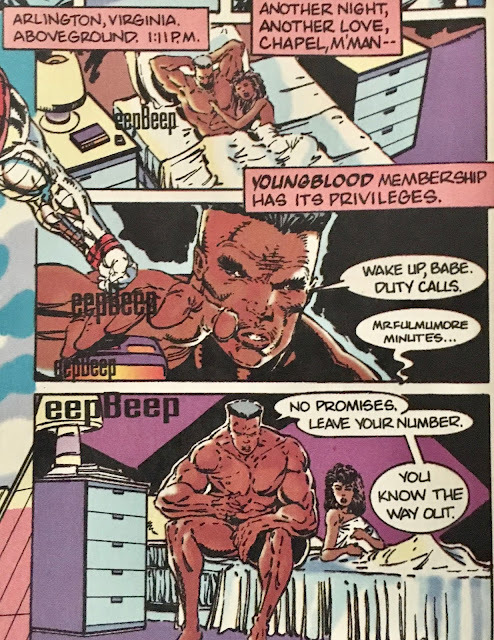
This is a page from "Youngblood #1" (April 1992) (Image Comics)
Creator, Plot, Pencils & Inks – Rob Liefeld Dialogue – Hank Kanalz Color Design – Brian Murray Color Separations – Digital Chameleon Editor-in-Chief – Chris Ulm
This is Chapel and an apparently unnamed woman.
I have no idea if this is the exact panel being referenced (particularly given I have avoided Liefeld's art in the wild wherever possible, even though that's admittedly somewhat difficult given how much he's drawn over the years). I only know about this page because of The 40 Worst Rob Liefeld Drawings. (The link not the comic is recommended read, it's very funny, as is the sequel). Notably, Dolph and Alex's pose is nearly identical to that first panel, and Chapel is also apparently hairless.
Captain Laserhawk: Blood Dragon Remix is based on the Far Cry 3 DLC, Blood Dragon, which is an homage to 1980s action films, cartoons, and video games. The protagonist's (Dolph Laserhawk) design is very clearly heavily reliant on the design for the DLC's protagonist, Sergeant Rex "Power" Colt. Rex looks a lot like a cross between Marvel's Winter Soldier (2005) and Cable, another Marvel Comics character who first appeared as a baby in 1986 (Chris Claremont (writer) and Rick Leonardi (pencils)) but later appeared for the first time in his more well-known adult appearance under Louise Simonson (writer) and Rob Liefeld (art) in 1990.
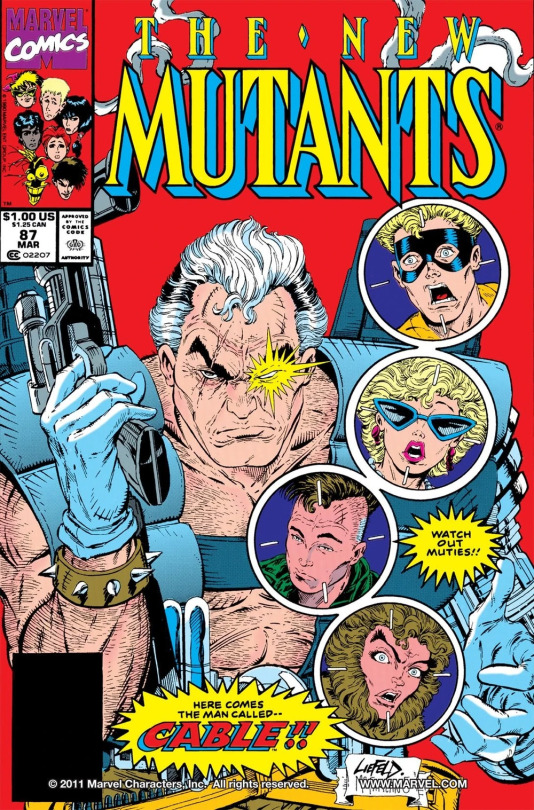
(Though Cable does... seem to have hair on his body, so... RIP Alex I guess).
Alex Taylor also looks a bit like a cross between Sabretooth (another Marvel character) and Shatterstar, a character created by Fabian Nicieza (writer) and Rob Liefeld (art) in 1991.
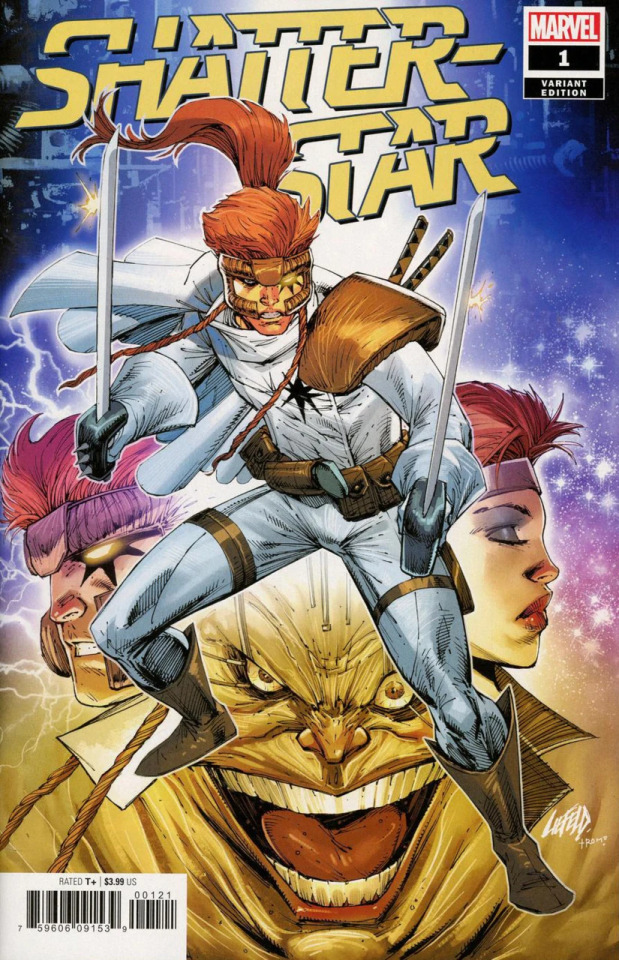
(This is mostly how Liefeld used to draw him. He looks a lot better under the hand of other artists these days, even just artists drawing for the same issues).
I don't think all roads lead to Liefeld. The guy mimicked a lot of stuff that was popular back then as far as I can tell. But even Kun's cover reminds me of a lot of covers Liefeld would draw (but actually good, because Kun's a good artist, and Liefeld is not).
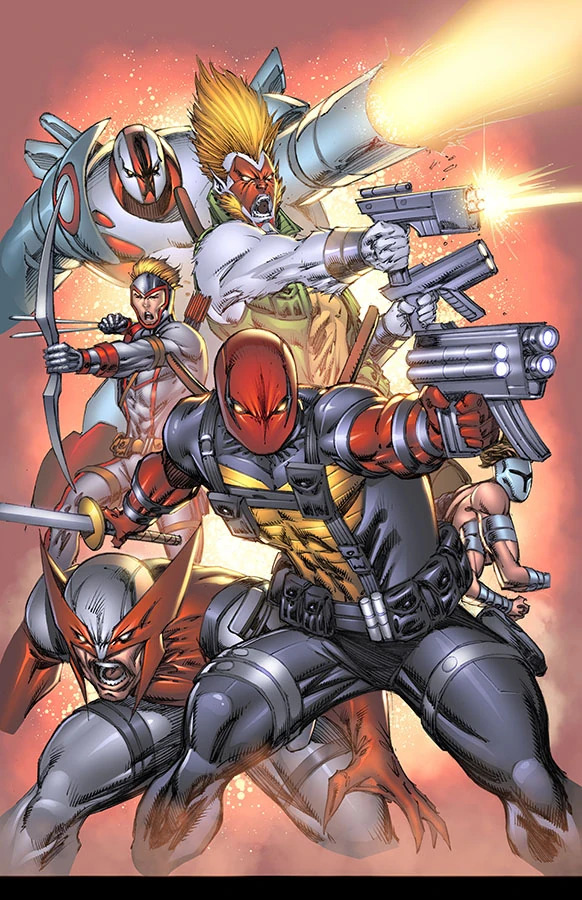
Hallmarks of Liefeld's covers: lots of weapons everywhere, particularly guns, lots of buff dudes standing close together, giant crotches, and some wild hairstyles. (I like to think a theory for the Laserhawk animated series is "what if the homo-eroticism of all this wasn't subtext").
Statistically speaking, it's probable that first screencap references a lot of things, likely the same stuff Liefeld was inspired by, and maybe only unintentionally appears to look like that panel. But that terrible panel of Chapel was one of the first things in my mind when I saw it, because of how clearly this series is heavily referencing art from that era.
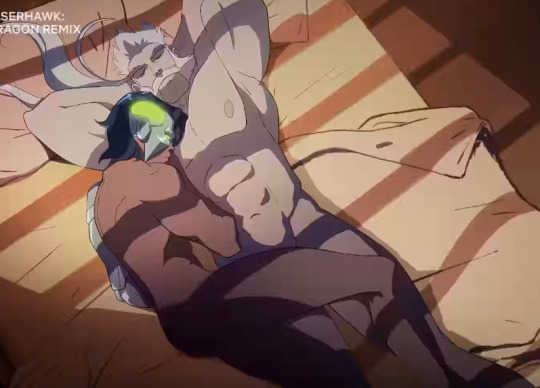
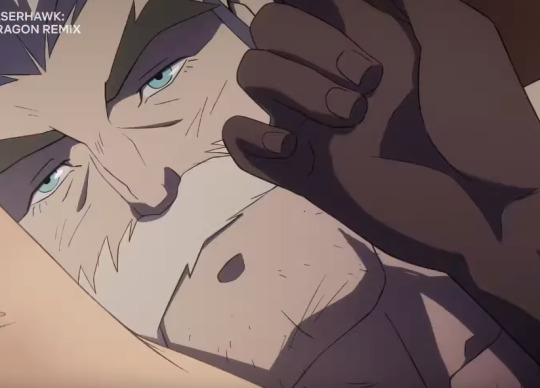
Okay... you got me. They're cute.
(Screencaps from the trailer for Captain Laserhawk: A Blood Dragon Remix, featuring the apparent protagonist and his canonical boyfriend whom Ubisoft describes as "the love of his life").
Also Tokyopop is doing the comic adaptation and the cover art by Bayou Kun <.< for the "boys love manga adaptation" - iOS
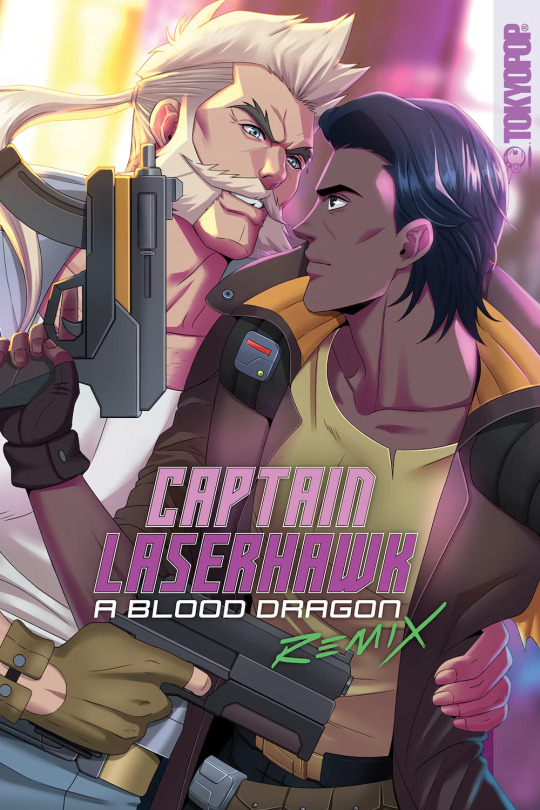
#I think the hairlessness makes it extra funny as a reference#like if this series is half a fuck you to Liefeld I wouldn't be upset#his art is so bad and he's everywhere#apparently he walked back his views on Shatterstar#which is good#his art's still bad though and it's always neat to see good artists draw the stuff he couldn't#like I can't say I love all the designs but I can appreciate nostalgic art in the hands of folks who can draw#also Dolph and Alex are just adorable so idc#laserhawk
244 notes
·
View notes
Text

THE RETURN!! -- "SAURON IS BACK!"
PIC INFO: Resolution at 1853x2547 -- Spotlight on the dreaded return of Sauron, the final page, a double splash page, no less, from "X-FORCE" Vol. 1 #5. December, 1991. Marvel Comics.
"Karl Lykos is no more, you pedantic, misshapen pustule... I have returned. Do you hear me, you soft, pink bags of rice paper flesh? SAURON IS BACK!"
-- SAURON to Toad (and the rest of non-Saurian, bipedal, organic life)
STORY/SCRIPT: Fabian Nicieza & Rob Liefeld
PENCILER(S): Rob Liefeld, Brian Murray, & Marat Mychaels
INKERS: Rob Liefeld & Marat Mychaels
COLORIST(S): Brian Murray & Renee Witterstaetter
LETTERER: Chris Eliopoulos
Source: https://view-comic.com/x-force-v1-005.
#Sauron#Dr. Karl Lykos#Energy Vampire#X-FORCE#X-FORCE Vol. 1#Supervillains#Marvel Universe#Blob#Marvel Comics#Fabian Nicieza#Rob Liefeld#90s Marvel#Karl Lykos#X-Villains#Rob Liefeld Art#The Blob#Savage Land#1990s#90s#Marvel#Brotherhood of Evil Mutants#New Brotherhood of Evil Mutants#Toad#Marvel Villains#Mortimer Toynbee
1 note
·
View note
Photo

Brigade vol 1 4 (1993) . Fatal Finale . Written by Rob Liefeld, Marat Mychaels and Eric Stephenson Penciled by Marat Mychaels Inked by Norm Rapmund and Paul Scott Colors by Brian Murray and Chameleon Prime Lettered by Kurt Hathaway Edited by Eric Stephenson Cover by Rob Liefeld, Norm Rapmund and Kiko Taganashi . Brigade and the Birds of Prey fought against Genocide and his hordes... . #brigade #battlestone #maratmychaels #robliefeld #90s #birdsofprey #atlas #coldsnap #kayo #seahawk #stasis #thermal #ironside #swift #talyn https://www.instagram.com/p/ChMEAEFsSFF/?igshid=NGJjMDIxMWI=
#brigade#battlestone#maratmychaels#robliefeld#90s#birdsofprey#atlas#coldsnap#kayo#seahawk#stasis#thermal#ironside#swift#talyn
3 notes
·
View notes
Text
Batman: The Killing Joke Deluxe Edition review

It's an inquisitive one, The Killing Joke. From one viewpoint, it's one of the most loved and persuasive Batman stories at any point composed, and seemingly the "conclusive" Joker story - this new Deluxe Edition matches with The Dark Knight, whose makers have guaranteed it as a critical effect on their depiction, while Tim Burton expressed comparable back while making his own Batman in 1989. But, despite its huge ubiquity (during a time well before realistic books advanced into bookshops, it was republished an uncommon number of times), it likewise comes in for some analysis - not least from its makers.
Essayist Alan Moore has himself utilized the words "cumbersome, misconceived and without any trace of genuine human significance" to depict it - and keeping in mind that he's maybe being excessively brutal, he does have a point in that it's not at the level of his actual magnum opuses (Watchmen, V for Vendetta, The League of Extraordinary Gentlemen).
The treatment distributed to previous Batgirl Barbara Gordon, while it ostensibly prompted her to turn into an undeniably more huge person in her new job as Oracle, is by the genuinely disagreeable (it more regrettable searches by and large, mind - the pattern for female characters to be fiercely utilized as minimal more than impetuses for male legends' tension has just developed since the last part of the 80s, however, you can barely hold this one example against the one who composed Halo Jones, Lost Girls and LOEG's Mina Murray), and keeping in mind that the ethically uncertain closure is an extraordinary scene by its own doing, it doesn't square well with the activities of the Joker in the first pages.
Yet, it is a magnificently environmental story, and the story of the one who might turn into the Joker (indeed, potentially - it's not difficult to fail to remember that it's not intended to be a genuine memory) is affectingly heartbreaking. It's additionally covered with slick minutes - in addition to the end metaphorical joke, yet in addition to the very great, "it's unfilled" weapon gag and the "Loo-oo-pony" song. Where it truly sparkles, however, is in the workmanship - it's a sorry disgrace that craftsman Brian Bolland, to be perfectly honest, is such a carefully sluggish laborer that he ruled against truly doing inward fine art once more (focusing completely on covers) after Killing Joke - no one draws the Joker very like him (no one draws hair very like him, either), and he's a brilliantly expressive and fresh narrator.
It's maybe extending it to say he's "squandered" on cover craftsmanship - because he's just about truly amazing - however inside work, for example, this means that exactly what we're missing. And yet even Bolland, similar to Moore, was in every case to some degree disappointed with the outcome.
While not accusing colorist John Higgins (who was gotten a short notification to make a fast showing after Bolland had taken such a long time on the pencils), he was frustrated that the tone didn't match his unique vision - thus, with this new version, has made a move to return to the first inked workmanship and give it a PC improved makeover. Even though it must be expressed that as far as progress in further developing the first, the outcomes are a mishmash.
The greatest change is in decreasing the flashback groupings to greyscale, just shading any red things and unpretentiously expanding their immersion until the Red Hood's ensemble shows up. It's great, if the marginally predictable elaborate decision, and it functions admirably rather than the sharp tones of the Joker himself. Somewhere else, however, a portion of the progressions appear to have to a lesser extent a point-expanding definition for it, yet giving the book an over-the-top "present day" feel as opposed to seeming as though it was imprinted during the 1980s. All things considered, Bolland is likewise permitted to change specific subtleties to a great extent - these incorporate, unsettlingly, evolving the "tears" in the Joker's post-change to drops of blood
Unexpectedly, in the meantime, maybe Moore's greatest meat with the book - that it was simply at any point truly planned to be a twofold length one-off Batman story (even though Bolland questions the idea that it was expected for a yearly), and he was subsequently shocked to find it trapped in cardstock and showcased as a "realistic book" - is ostensibly exacerbated by delivering it in a rich hardback configuration.
Limiting additional items, you're essentially paying twelve quid or so for only 48 pages of a genuine story. Those additional items, in the interim, incorporate a couple of pieces and sways of sketch and reference workmanship, in addition to Bolland's other distributed Batman story - a short vignette he likewise composed, initially for the Batman: Black and White gathering and shaded here interestingly. As you'd expect, it looks perfect, and it's a dim little person piece, however, it doesn't feel colossally fundamental.
On the off chance that you haven't perused the book - or on the other hand, assuming you honestly love it to need to claim the most ideal that anyone could hope to find version - then, at that point, a wonderful show will sit gladly on any rack.
Yet, notwithstanding the strong cover, is it truly worth paying such a great amount for what is, basically, over two single comics of material? The actual story, notwithstanding its imperfections, is compulsory perusing similarly as present-day superhuman comics go, however, I'd nearly be enticed to recommend holding on to check whether the recoloring position - which is tasteful, regardless of whether it dishonestly dates the book - makes it into the following softcover printing.
It's an extraordinary comic, sublimely introduced - yet similarly, as to its unique distribution, it's essentially in some unacceptable organization.
I give 4 out of 5 to this comic book.
download batman the killing joke deluxe edition

#avengers#marvel cinematic universe#marvel#comics#marvel comics#batman#the joker#villains and heroes
3 notes
·
View notes
Text










Wolverine starring on the front covers of Marvel Comics Presents #1-10 (early September 1988-early January 1989) for the "Save the Tiger" serial, written by Chris Claremont, art by John Buscema (pencils) and Klaus Janson (inks). Covers by:
#1 Walt Simonson
#2 Alex Saviuk/Klaus Janson
#3 John Romita Jr./Bob Wiacek
#4 Al Milgrom /P. Craig Russell
#5 John Buscema/Klaus Janson
#6 John Buscema/Klaus Janson + Tom Sutton (Man-Thing, sprawling from the back cover)
#7 Bob Layton
#8 Charles Vess
#9 Brian Murray
#10 Mike Harris
A new Colossus serial started in MCP #10.
#Comics#Wolverine#Marvel Comics Presents#Walt Simonson#Klaus Janson#Alex Saviuk#John Buscema#Bob Layton#Charles Vess#P. Craig Russell#Al Milgrom#John Romita Jr.#Bob Wiacek
110 notes
·
View notes
Text

The Badger #38, August 1988, Pencils: Brian Murray
57 notes
·
View notes
Photo

#WaltDisney's #Sebastian #1 (1992) #TomBancroft & Brian Garvey Cover / Bill Fugate, Dan Gracey & Jackson Guise Pencils / Peter David, #DougMurray & Scott Saavedra Stories, Walt Disney Productions Cover pencils by Tom Bancroft, inks by Brian Garvey. Fiddling Around, script by #PeterDavid, pencils by #JacksonGuice, inks by #BrianGarvey; Sebastian's old mentor, a fiddler crab, chastises his musical ability; And so Sebastian sets off on a world quest to discover new forms of music. Sebastian in Scotland, script by Doug Murray, pencils by Bill Fugate, inks by Dave Hunt; Sebastian scares off a band of wicked Scottish fisherman by posing as the Loch Ness Monster. Out of Africa and into the Frying Pan, script by Pat McGreal and Dave Rawson, pencils by Jorge Sanchez, inks by Roberto Bat; Sebastian is chased by predatory animals in Africa. The Big Finale, script by Scott Saavedra, pencils by Dan Gracey, inks by Brian Garvey; Sebastian is used as a drumstick by a band of bongo-playing islanders. https://www.amazon.com/gp/product/B0867ZVFPX
2 notes
·
View notes
Text
From the Point Nov. 22, 2019
This unrelenting run of injuries this season has provided the Penguins and their fans a couple of things. Well, beyond disbelief and fits of rage. Extended absences for Sidney Crosby, Evgeni Malkin, Kris Letang and several others served as a reminder that the aforementioned Big Three are indeed mortal and on the wrong side of 30. They have also forced us to get a glimpse at the next wave of Penguins. That got me thinking this week about what the roster will look like three years from now. There will be significant turnover. Only seven players who were on the 23-man roster for the 2016-17 opener are still here. I'd say there is a decent likelihood that at least one of Crosby, Malkin and Letang is not on the team at the start of the 2022-23 season. For this projection, I opted to identify only the guys whom I believe have a chance of 80 percent or greater to be on the squad in 2022. These 80-percenters include prospects. I'll also give my rationale for not including some notable players with iffy long-term outooks. FORWARDS: Sidney Crosby: Crosby, who will be 35 when the puck drops on 2022-23, will play for the Pens as long as he wants. He's got a lot of tread on the tires, so you worry about injuries. But if he can stay relatively healthy, he has the smarts and skill to remain highly impactful. Jake Guentzel: Guentzel, who is near a 40-goal pace again this season, signed a team-friendly extension to stick around for several more years. He figures to earn multiple All-Star nods. Brandon Tanev: There was much hand wringing after the Penguins gave a six-year contract to this grinder. But his $3.5 million salary seems appropriate at the moment given the juice he's brought. In three years, if the cap keeps rising, that deal may still be OK. Teddy Blueger: As one of the charter members of #TeamTeddy, I'm projecting a little bit here. Bottom-six centers like Blueger are far from untouchable. But I think his game continues to blossom and he should come cheap. Pencil him in as the third-line center. Sam Lafferty: Like Blueger, the Hollidaysburg native can be locked in at a reasonable salary and may prove to be a useful winger. He's fast, has a little size and is a two-way player. Samuel Poulin: The 2019 first-rounder impressed the Penguins in camp and the preseason. He's been a beast for his junior team – did you see this goal? – and could be ready to seriously challenge for a roster spot next fall. He'll be an established NHLer by 2022. Nathan Legare: The goal-scoring winger, who was childhood friends with Poulin, might have more upside than Legare. He's got that big shot. If he improves his skating and rounds out his game, look out. OK, let's talk about the omissions. The big one is Malkin, whose deal is up after the 2021-22 season. I think he will be back. But it's below 80 pecent. Will Geno want to finish up in sunny Miami or less-sunny Magnitogorsk? Another tough decision was Patric Hornqvist. He'll make $5.3 million in 2022-23 but it's fair to wonder how this warrior's body will hold up. There are high hopes for prospect Filip Hallander but he will have to adjust to North American hockey. DEFENSEMEN: Brian Dumoulin: There is praise for Dumoulin below so I will keep it brief here. He is one of the NHL's most underrated blue-liners and his bargain contract runs through 2022-23. John Marino: The only question I have is whether the Hockey Hall of Fame will make Marino the first active player to be inducted or if he'll have to wait until the second he retires. Marcus Pettersson: The Penguins plan to lock up the lanky Swede long-term after they are allowed to on Jan. 1. Pettersson will be just 26 when the 2022-23 season begins. Calen Addison: Addison, a slick-skating righty with plenty of swagger, might reach the NHL within the next year. He has 21 points in 23 games for his junior team. He needs to get better defensively. But the puck-mover is a perfect fit for the Penguins. You surely noticed that Letang and Justin Schultz did not make this list. Schultz will be a free agent after this season and might not fit into the team's budget. Letang is in the same boat as Malkin. His contract also expires in the summer of 2022. And while there is a decent chance he finishes his career here, the odds might be closer to 50/50. As for the prospects, I thought about including Pierre-Olivier Joseph but he's not a sure thing to make the NHL. GOALIES: Matt Murray: That's it. That's the list. Opinions are split on Murray here in Pittsburgh, but the ones that matter most are in Penguins management, and they'd like to sign Murray to a new deal this summer. Given his unique resume and that he will be an RFA, this negotiation should be fascinating. But it will be surprising if something doesn't get done here.
THREE STARS OF THE PAST WEEK 3. Brandon Tanev. The endearingly obnoxious winger got bumped up to the second line to play with Jared McCann and predictably provided a spark. He also chipped in with some offense, too. He had two assists in the win over Toronto then two goals Tuesday. 2. Bryan Rust. Rust has been unreal since returning from that hand injury, scoring eight goals in 11 games. He had a goal in each of the last three games. The entire top line has been really good. Evgeni Malkin and Jake Guentzel have meshed pretty well with Rust's help. 1. Brian Dumoulin. You might be scratching your head at this one, but he has quietly remained excellent without Kris Letang. Playing next to John Marino, Dumoulin had a plus-7 rating the last three games, showing he's more than just Letang's trusty sidekick.
EXITING THE ZONE Sign me up for a Pens-Isles rematch in the playoffs. All three meetings this month were wildly entertaining. ... It was a little surprising to see Juuso Riikola get scratched Thursday. He remains inconsistent, but with Letang and Schultz out, you'd figure coach Mike Sullivan would want him in the lineup for power play purposes. Sullivan used Dumoulin instead, but I'd have given Marino a look on the top unit. ... Matt Murray has been better than his average .907 save percentage would indicate, but the Penguins, with Crosby and other key players out, needed him to steal one of those overtimes against the Islanders. Neither of Brock Nelson's game-winners were particularly impressive. ... With Crosby out, faceoffs have been a big problem. The Penguins won just 39.7 percent of them the last three games. ... When the Penguins brought back both Chad Ruhwedel and Zach Trotman with cheap contracts this offseason, I thought it was redundant. In hindsight, I'm a dope. Rutherford learned at some point during his long Hall of Fame career that you can't have too many righties on D.
1 note
·
View note
Link
by ROY EDROSO MAY 14, 2018
The Age of Trump has conservative intellectuals in an embarrassing predicament: Trump has either turned conservatism into, or revealed conservatism to be, nothing but a gigantic grift, so who needs conservative intellectuals? When Republican tax cuts are such a brazen payoff to the super-rich that even tax-hating voters don’t believe it will ever trickle down, and when Michael Cohen taking obvious bribes from AT&T and Novartis exemplifies “draining the swamp,” how could anyone listen to a right-wing pencil-neck talk about conservative policy without laughing?
But don’t worry about the pencil-necks, they’ve found a way around this dilemma by escalating the decades-long culture war, diverting their audiences’ attention from the real issues with little melodramas in which conservatives are oppressed by Black Panther, Wonder Woman, and Shakespeare in the Park (boo!), then are rescued at the last minute by right-wing stars like Kid Rock and Kanye West (hurray!).
And now conservatives even have their own Wingnut Avengers for their Infinity Culture War: the Dark Intellectual Web, a group of conservatives and crypto-conservatives whose unifying principle seems to be that liberals are mean and therefore out of step with the millions of Americans who have never heard of the Dark Intellectual Web.
Last Tuesday Bari Weiss filed a gripping story at the allegedly leftist New York Timesabout the “Renegades of the Intellectual Dark Web,” who are either known conservatives like Ben Shapiro or public figures whose fans are nearly 100 percent conservative, usually because they have something bad to say about minorities, but who resist the label and prefer to call themselves “libertarians” or “classical liberals.”
IDW superheroes include Douglas Murray, one of those Islam-Wants-to-Kill-Us-All types; Christina Hoff Sommers, a Milo-fan anti-feminist libertarian who doesn’t like Muslims either; Claire Lehmann, who believes “nationalism is the antidote to racism,” and claims to have been “blacklisted” for “criticizing feminism”; atheist It Boy, Ben Carson fan, and idol of the alt-right Sam Harris; right-wing intellectual of the moment, clean-your-room scold, trans-rights opponent, and disbeliever in the gender pay gap Jordan Peterson, et alia.
According to Weiss, what unifies this crew is not their tendency to identify with the powerful against the powerless, but rather that “each is determined to resist parroting what’s politically convenient” — which I guess is the cool new IDweb way of saying “politically correct” — and their alleged willingness “to disagree ferociously, but talk civilly.” Weiss did not offer evidence for this claim.
Weiss’ article was mocked by mean liberals, particularly because Weiss portrayed the IDweb as “feeling largely locked out of legacy outlets” and “purged from institutions that have become increasingly hostile to unorthodox thought,” a sort of Kevin Williamson what-about-my-right-to-be-in-your-magazine maneuver. Weiss didn’t help her cause by claiming in a series of tweets (seconded by her right-wing fans) that, if followers of Donald Trump were racist and sexist, it was only because liberals had turned them racist and sexist by making fun of them, which is how Hitler took over Germany.
Right-bloggers and other conservatives sprang to this classic conservative mix of self-aggrandizement and persecution like kittens to catnip, though not as gracefully.
At Hot Air, John Sexton celebrated podcaster Dave Rubin, “one of the leading talkers in the IDW,” because “Rubin isn’t screaming. He isn’t angry,” which is apparently remarkable among conservative intellectuals. To demonstrate Rubin’s appeal, Sexton quoted some of his “rational, intriguing, thought-provoking content.” For example, if you “believe that people should be judged by their character, not their skin color” and “in freedom of religion,” Rubin has said, then “you’re probably not a progressive,” because progressives go around “banning speakers whose opinions [they] don’t agree with from college campuses…prohibiting any words not approved of as ‘politically correct,’ ” and “putting ‘Trigger Warnings’ on books, movies, music, anything that might offend people” — as, coincidentally, I was just doing on my day off, because my week had been taken up in recreational abortions and otherwise épatering le bourgeois.
Andrew Sullivan admitted the IDweb had “not been silenced,” but that they “have definitely been morally anathematized, in the precincts of elite opinion,” to a collective gasp and the covering of ladies’ ears. Sullivan accused Ta-Nehisi Coates of doing to newly right-woke Kanye West as elite opinion had done to the IDweb by “subjecting West to anathematization, to expulsion from the ranks.” (For the uninitiated, Coates is a writer known mainly to readers of political magazines, while West is a global superstar; but, like the Dark Web superstars, West suffers mightily from anathema and expulsion.)
At National Review David French said the IDweb guys were also oppressed because “the path to prominence for many of these now-popular people has sometimes been painful.” For example, Peterson had “battled (at great professional risk) for free speech in Canada,” and paid for it by remaining a tenured professor while making huge bank off videos and TV shows.
IDweb fans were even more oppressed than Peterson, French pressed on, because they “fear that even asking questions could endanger their livelihoods and ruin their public reputations.” The best French could do to explain this is by saying that while, admittedly, “the law of free speech has mainly improved…the culture of free speech has decayed” — that is, “people in academia and in much of corporate America…report increasingly politicized workplaces, with HR departments weaponized in the service of identity politics social-media accounts monitored for thought crimes.” Insult your co-workers as biologically inadequate, and you might lose your job! This ain’t the country your pappy grew up in, assuming he was white.
History suggests the IDweb phenomenon will be evanescent and mainly benefit its promoters, like the hippie-dippy “Crunchy Conservatism” once advocated by current Benedict Option scold Rod Dreher, or the fart-jokey “South Park Conservatism” briefly pimped by Brian C. Anderson, now editor of City Journal. But in the current environment of perpetual right-wing grievance, IDweb conservatism may have more staying power because there are plenty of angry wingnuts out there.
For example: You may have heard about white Yale student Sarah Braasch, who last week called the cops on a black student who had been napping in the dorm lounge; on a previous occasion, Braasch had chased another black student out of the dorm.
Turns out Braasch was not just a run-of-the-mill racist, but what we might call an Intellectual Dark Racist. She has written at length about her anger at seeing women in hijabs — which she assumed they’d been forced into wearing, because Muslims, right? — and then congratulated herself on her bravery in saying so out loud: “If I should ever get into any kind of a dispute or altercation with anyone who claims to be Muslim,” she fantasized, “I could conceivably be prosecuted for a hate crime,” in part because, she said, “I love hate speech.” But hark, libtards, “you can’t scare me,” cried Braasch defiantly: “What are you going to do? Kill me? Put me in prison? We’re all going to die someday.”
Braasch has it all: Intense fear of at least two minorities, a persecution complex, and a tendency toward provocative declarations. If she plays her cards right, she could be Bari Weiss’ next superstar.
4 notes
·
View notes
Photo

Brigade vol 1 3 (1993) . Battlefront . Written by Marat Mychaels and Eric Stephenson Penciled by Marat Mychaels Inked by Norm Rapmund and Paul Scott Colors by Brian Murray and Digital Chameleon Lettered by Kurt Hathaway Edited by Eric Stephenson Cover by Paul Scott and Danny Miki . #brigade #image #maratmychaels #paulscott #dannymiki #atlas #battlestone #kayo #seahawk #stasis #thermal #coldsnap #birdsofprey #ironside #talyn #swift #thefactor #knockdown #trek #reign https://www.instagram.com/p/CfX6H_rqYHS/?igshid=NGJjMDIxMWI=
#brigade#image#maratmychaels#paulscott#dannymiki#atlas#battlestone#kayo#seahawk#stasis#thermal#coldsnap#birdsofprey#ironside#talyn#swift#thefactor#knockdown#trek#reign
4 notes
·
View notes
Photo

Happy Valentine’s Day! To celebrate here at Man Creates Dinosaurs, today’s post will all deal with one thing and one thing only: The sex lives of dinosaurs. The question of dinosaur sex was one that was actually ignored for many years by paleontologists. This had nothing to do with the paleontologists themselves but rather the general tenure of late 19th-Century/early 20th-Century biology as a whole. While every scientist acknowledged that sex was a vital part of any organism’s life it was nevertheless not something you talked about in polite company - especially as the sex lives of animals could be, at times, rather improper by human standards. Turn of the century naturalist George Murray Levick, who made one of the first prolonged studies of penguins, was so shocked by the “sexual depravity” of the birds that when he published his field notes he censored all the parts having to do with sex so as to spare his fellow scientists the horror of knowing what he saw. (Lavick’s notes on penguin sex were eventually published in 2012. You can read them here.) Today scientists are far less prudish about discussing the sex lives of animals, including dinosaurs. One paleontologist who became notorious for his association with the subject was Beverly Halstead (1933 – 1991) who once bragged to Omni magazine that he was responsible for the first published paleoart of two dinosaurs doing-it… Which we will get to, trust me. However Halstead was actually wrong on that account. According to Stephen R. Bissette’s authoritative essay on the history of dinosaurs in comics, “The Paleo Path,” the first depiction of two dinosaurs mating came from an issue of Charlton Comics’ Gorgo #13 (Jun. 1963) as part of a backup feature titled “From Beyond Time.” The writer and artist of this story are not credited but speculation suggests it may have been Joe Gill (writer) and Dick Giordano (pencils). As Bissette wryly notes the story seems to “imply that Brontosaurs mated by rubbing their necks together,” a thought which he confides provoked “some sniggering on the playground” of his youth.
Actually the idea that sauropods may have had “necks for sex” isn’t as bizarre as it sounds. As outlined by Brian Switek in his book My Beloved Brontosaurus, in 2006 paleontologist Phil Senter, building on the theories of zoologists Robert Simmons and Lue Scheepers about why giraffes evolved long necks, proposed that sauropods grew out their necks to such fantastic lengths in order to use them as weapons in the war of love. Male giraffes compete for females by bashing each other in the neck with their necks (You can watch that spectacle here with some accompanying techno) and Senter suspected that male sauropods probably did the same.
32 notes
·
View notes
Text
Dorktown: Bill Belichick keeps drafting good quarterbacks because he’s bored

Since drafting Tom Brady in 2000, Belichick has never had to worry about finding his quarterback of the future. And yet, he can’t help himself. Here are some charts.
Sunday we saw Jacoby Brissett, who used to be a Patriots quarterback, return from injury and lead the Colts to a win after taking back the reins from Brian Hoyer, who used to be a Patriots quarterback. Elsewhere, Jimmy Garoppolo, who used to be a Patriots quarterback, engineered a game-winning drive to squeak past the Cardinals, who are coached by Kliff Kingsbury, who used to be a Patriots quarterback. In Washington, offensive coordinator Kevin O’Connell, who used to be a Patriots quarterback, saw his unit sputter out in a loss to the Jets. And finally, New England pulled out a win despite a lackluster performance from Tom Brady, who is currently the Patriots’ quarterback. He also, and you can’t tell me I’m wrong, used to be a Patriots quarterback.
In this century, thanks to Brady, the New England Patriots have had far less reason to draft a quarterback than almost any other NFL team.
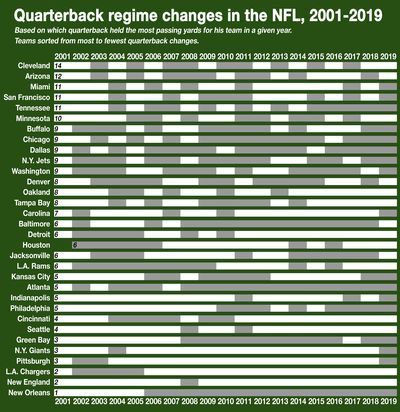
Only the Saints, who dusted off their hands after neatly transferring power from Aaron Brooks to Drew Brees in 2006, have had to make fewer changes at quarterback than the Patriots. Even so, the Pats didn’t face any sort of long-term dilemma when Matt Cassel took over for the injured Brady in 2008, since they knew he was returning.
Deciding which quarterback to draft is one of the toughest and most important calls an NFL team has to make, so it’s sort of comical that Bill Belichick, the smartest man in football, hasn’t even had to think about it for nearly two decades.
And yet he does! He can’t help himself. It’s a particular talent of his that just can’t remain dormant. Let’s look at that chart again, this time highlighting the quarterbacks he’s chosen who have gone on to find success elsewhere in the NFL.
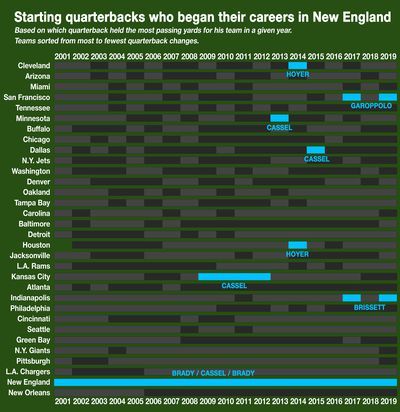
Garoppolo and Brissett are franchise quarterbacks who are chucking some very good football for playoff contenders. Cassel was a low-potential, hyper-conservative quarterback who I love unconditionally; despite his limitations he strung together a four-year run with the Chiefs and wasn’t terrible. Hoyer, a serviceable option who has started at least one game for six different teams, is the reason I had to use “chosen” instead of “drafted” above, as he actually went unselected in the 2009 draft only for Belichick to sign him off the street the following day.
Including the Patriots themselves, eight teams — exactly 25 percent of all teams in the NFL — have picked a Belichick-selected backup to be Their Guy for the plurality of a season. If we expand the definition to ex-Pats who have simply thrown a pass for another team, we’re talking about 13 franchises. That’s within spitting distance of half the teams in the NFL.
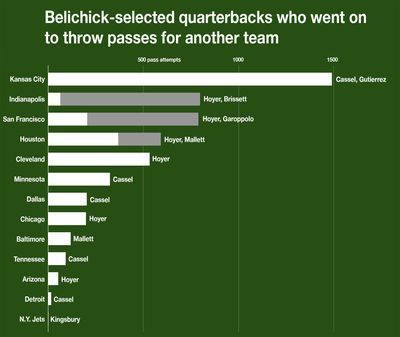
These names represent a pretty wide variation in quality, from the very impressive Garoppolo and Brissett to the unfortunate Ryan Mallett. But on balance, Belichick is very, very good at drafting quality quarterbacks without spending quality picks. To understand this properly, let’s look at some bullshit.
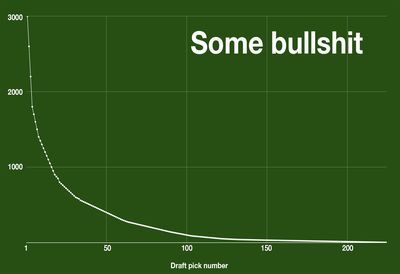
This is the most commonly-used iteration of the “Draft Pick Trade Value Chart”. It was devised by Jimmy Johnson as a means of assessing the relative value of a draft pick. For instance, the No. 1 overall pick is valued at 3,000 “points”, but only six picks later, the No. 7 pick is valued at just 1,500 points. I say it’s bullshit because it assigns a definite value to a draft pick, a thing that is wildly dependent on context, but I will acknowledge that as a very loose and general set of guideposts, it’s useful.
For our purposes, it’s especially useful as insight into how NFL teams value their picks, because they themselves tend to rely heavily on this chart. The early picks are, indeed, disproportionately valuable to them. Belichick doesn’t even think about using them on a quarterback.

Once he struck gold with Brady, he never had any incentive to, but it’s amazing to see what he’s done with a couple fistfuls of low-value draft picks. Unsurprisingly, the Patriots have spent far less draft-pick value on quarterbacks than the majority of NFL teams.
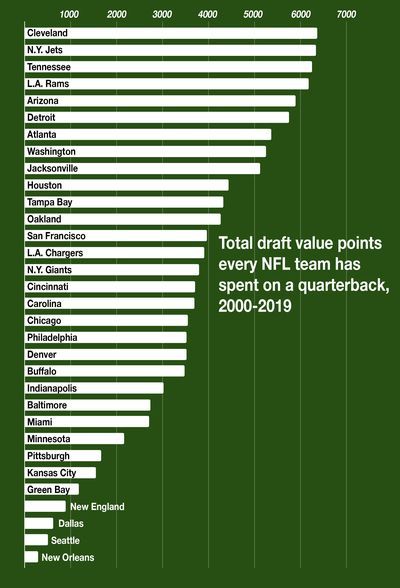
It’s hard not to notice that the bottom seven teams on this chart — the ones who have spent less draft capital on quarterbacks than anyone — all have quarterbacks who most teams would kill for. It’s a predictable and cruel outcome. Teams who strike gold once get to settle their quarterback situation for the next decade-plus, and teams who bet big on a quarterback and miss the mark just have to go back to the well and try again.
But just because it’s predictable doesn’t mean it’s not really funny.
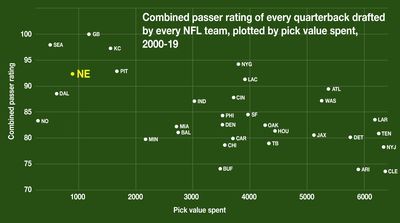
With all their numbers combined, Belichick-drafted quarterbacks hold a cumulative passer rating of 92.3. This eclipses 26 teams, most of which have spent at least three times as much draft capital on passers.
What this 92.3 passer rating doesn’t reflect is longevity. Bored by the endless success of Brady, Belichick continued to flip low-value picks (or, in Hoyer’s case, a day-after-draft signing) into quarterbacks with long, successful careers. Quarterbacks he didn’t even need.
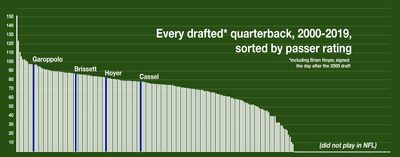
Even ignoring Brady, those four represent a very strong track record, particularly since all four were had at a bargain. Let’s look again at the “combined passer rating” chart, but this time, plot New England as though Brady never existed.
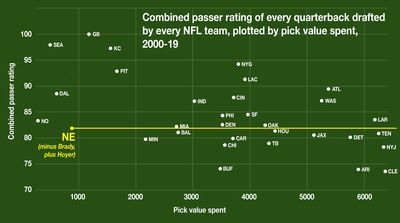
Seemingly for the hell of it, and with a tiny amount of draft firepower, Belichick assembled an army of quarterbacks he didn’t need that surpasses those drafted by the Vikings, Ravens, Bills, Bears, Panthers, Bucs, Texans, Jaguars, Lions, Cardinals, Titans, Jets and Browns. Thirteen teams. Nearly half the NFL.
Again, passer rating accounts for quality, not quantity, so let’s look at the latter. It’s borderline crude to assess quarterbacks solely by passing yards, but it does at least represent on-the-field production. And of those 13 teams above, Belichick’s gaggle of elevated backups has out-gained eight of them in terms of yardage.
This is embarrassing.
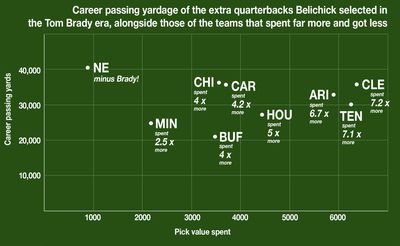
This comes with an important caveat: many of these teams spent lots of draft capital on decent-to-great quarterbacks who still have a ton of football left to play (Marcus Mariota, Deshaun Watson, Kyler Murray, Baker Mayfield, Josh Allen). But remember that the Patriots’ figure here is probably rising even faster, as both Garoppolo and Brissett are in the same boat.
Since those numbers are adding up in the service of other teams, how much has Belichick actually benefited from this wildly impressive draftsmanship?
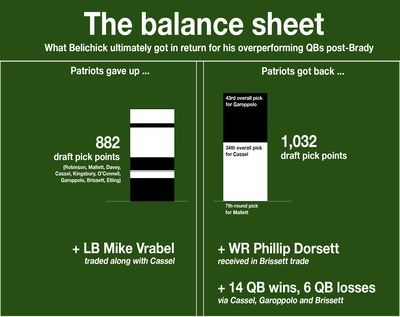
Relatively speaking, not much. He was able to flip all these picks for slightly better draft position, and in the meantime, these quarterbacks contributed a 14-6 record. While certainly significant, it’s a pittance compared to the long-term value Garoppolo and Brissett bring to the 49ers and Colts all by themselves.
Belichick is magnificent at a skill he doesn’t need. And while exercising this skill for dimes on the dollar is still good football strategy, I’ve chosen to invent a narrative of my own: Belichick just loves solving football problems.
There’s a scene in Belichick’s episode of A Football Life in which he’s sitting in his office, slouched in an office chair, mumbling with Brady over how the hell to play against the Ravens’ Ed Reed. These couple of frames manage to capture his personal Valhalla.

Weird stack of home audio hardware that probably includes a turntable and/or Minidisc player. Jarringly mismatched furniture. Cherry-wood desk from 1994. Nothing on the walls. Framed artwork perilously set on top of the couch on the far wall. Shirt sleeves that look like they were hacked off with a pocket knife.

Dell laptop that is two feet tall when closed. VGA port on laptop? Several other cords jammed into laptop. Ethernet cable in the year 2011. Quad-shielded flat gray cable that looks like it’s only sold at Home Depot and is probably plugged directly into a fuse box. External monitor faced at 90-degree angle in act of open warfare against the principles of feng shui. Monitor has either an AC jack or an audio output positioned near the top for reasons known only to God. Bose wave radio and pencil sharpener from 1979 on windowsill.
Number 2 pencil. A man and his football problems. Belichick is mildly annoyed and has never been more happy.
The majority of this data was found via Pro-Football-Reference’s Play Index.
0 notes
Link

#Supreme #1 (1992) #RobLiefeld Silver Foil Logo Cover, Brian Murray Pencils, Brian Murray & Rob Liefeld Story, Enigma 1st Appearance As Supreme soars towards his homeworld, a certain Jason Temple deploys the genetically enginered superhero team Heavy Mettle to stop him in his tracks. A deadly battle ensues from their disbelief of Supreme announcing his identity of the Supreme that left Earth decades ago! But he's returned and his presence is invoked by Temple, appointing him leader of Heavy Mettle. https://www.amazon.com/dp/B098BGLK21?ref=myi_title_dp
0 notes